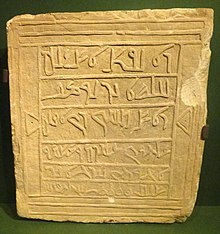lingvo.wikisort.org - Alphabet
The Nabataean script is an abjad (consonantal alphabet) that was used by the Nabataeans in the second century BC.[2][3] Important inscriptions are found in Petra (now in Jordan), the Sinai Peninsula (now part of Egypt), and other archaeological sites including Abdah (in Palestine) and Mada'in Saleh in Saudi Arabia.
![Nabataean Kingdom, Aretas IV and Shaqilath, 9 b. C. - 40 a. D., AE18.
On the reverse, an example of Nabataean script: names of Aretas IV (1st line) and Shaqilath (2nd and 3rd line).[4][5]](http://upload.wikimedia.org/wikipedia/commons/thumb/4/49/Coin_of_Aretas_IV_and_Shaqilath.jpg/220px-Coin_of_Aretas_IV_and_Shaqilath.jpg)
| Nabataean script | |
|---|---|
| Script type | Abjad
|
Time period | 2nd century BC to 4th century AD |
| Direction | right-to-left script |
| Languages | Nabataean language |
| Related scripts | |
Parent systems | |
Child systems | Arabic script |
| ISO 15924 | |
| ISO 15924 | Nbat (159), Nabataean |
| Unicode | |
Unicode alias | Nabataean |
Unicode range | U+10880–U+108AF Final Accepted Script Proposal |

History
The alphabet is descended from the Aramaic alphabet. In turn, a cursive form of Nabataean developed into the Arabic alphabet from the 4th century,[3] which is why Nabataean's letterforms are intermediate between the more northerly Semitic scripts (such as the Aramaic-derived Hebrew) and those of Arabic.

Comparison with related scripts
As compared to other Aramaic-derived scripts, Nabataean developed more loops and ligatures, likely to increase speed of writing. The ligatures seem to have not been standardized and varied across places and time. There were no spaces between words. Numerals in Nabataean script were built from characters of 1, 2, 3, 4, 5, 10, 20, and 100.
| Nabatean | Name | Arabic alphabet |
Syriac alphabet |
Hebrew alphabet |
|---|---|---|---|---|
| ʾĀlap̄/ʾAlif | ء ا | ܐ | א | |
| Beth/Ba | بـ ب | ܒ | ב | |
| Gamal/Jim | جـ ج | ܓ | ג | |
| Dalath/Dal | ﺩ | ܕ | ד | |
| Heh | هـ ه | ܗ | ה | |
| Waw | ﻭ | ܘ | ו | |
| Zain | ﺯ | ܙ | ז | |
| Ha/Heth | حـ ح | ܚ | ח | |
| Teth | ﻁ | ܛ | ט | |
| Yodh/Ya | يـ ي | ܝ | י | |
| Kaph | كـ ك | ܟ | כ / ך | |
| Lamadh/Lam | لـ ل | ܠ | ל | |
| Mim | مـ م | ܡ | מ / ם | |
| Nun | نـ ن | ܢ | נ / ן | |
| Simkath | ܣ | ס | ||
| 'E/Ain | عـ ع | ܥ | ע | |
| Pe/Fa | فـ ف | ܦ | פ / ף | |
| Ṣāḏē/Ṣad | صـ ص | ܨ | צ / ץ | |
| Qoph | قـ ﻕ | ܩ | ק | |
| Resh/Ra | ﺭ | ܪ | ר | |
| Šin/Sin | ﺳ س | ܫ | ש | |
| Taw/Ta | تـ ﺕ | ܬ | ת |
- Note that the Syriac and Arabic alphabets are always cursive and that some of their letters look different in medial or initial position.
- See Aramaic alphabet § Letters for a more detailed comparison of letterforms.
Unicode
The Nabataean alphabet (U+10880–U+108AF) was added to the Unicode Standard in June 2014 with the release of version 7.0.
| Nabataean[1][2] Official Unicode Consortium code chart (PDF) | ||||||||||||||||
| 0 | 1 | 2 | 3 | 4 | 5 | 6 | 7 | 8 | 9 | A | B | C | D | E | F | |
| U+1088x | 𐢀 | 𐢁 | 𐢂 | 𐢃 | 𐢄 | 𐢅 | 𐢆 | 𐢇 | 𐢈 | 𐢉 | 𐢊 | 𐢋 | 𐢌 | 𐢍 | 𐢎 | 𐢏 |
| U+1089x | 𐢐 | 𐢑 | 𐢒 | 𐢓 | 𐢔 | 𐢕 | 𐢖 | 𐢗 | 𐢘 | 𐢙 | 𐢚 | 𐢛 | 𐢜 | 𐢝 | 𐢞 | |
| U+108Ax | 𐢧 | 𐢨 | 𐢩 | 𐢪 | 𐢫 | 𐢬 | 𐢭 | 𐢮 | 𐢯 | |||||||
| Notes | ||||||||||||||||
See also
References
- Himelfarb, Elizabeth J. "First Alphabet Found in Egypt", Archaeology 53, Issue 1 (Jan./Feb. 2000): 21.
- Everson, Michael (2010-12-09). "N3969: Proposal for encoding the Nabataean script in the SMP of the UCS" (PDF). Working Group Document, ISO/IEC JTC1/SC2/WG2.
- Omniglot.
- Yaʻaḳov Meshorer, "Nabataean coins", Ahva Co-op Press, 1975; 114.
- https://en.numista.com/catalogue/pieces69784.html Numista
Другой контент может иметь иную лицензию. Перед использованием материалов сайта WikiSort.org внимательно изучите правила лицензирования конкретных элементов наполнения сайта.
WikiSort.org - проект по пересортировке и дополнению контента Википедии